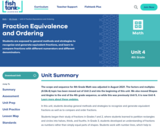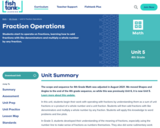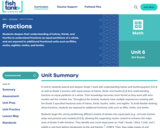
Students gather simple data, represent it on a bar graph, and answer simple, complex, and open-ended questions about the data.
- Subject:
- Mathematics
- Material Type:
- Lesson Plan
- Provider:
- BetterLesson
- Date Added:
- 12/01/2022


Students gather simple data, represent it on a bar graph, and answer simple, complex, and open-ended questions about the data.

Students are exposed to general methods and strategies to recognize and generate equivalent fractions, and learn to compare fractions with different numerators and different denominators.

Students start to operate on fractions, learning how to add fractions with like denominators and multiply a whole number by any fraction.

Students deepen their understanding of halves, thirds, and fourths to understand fractions as equal partitions of a whole, and are exposed to additional fractional units such as fifths, sixths, eighths, ninths, and tenths.

Students recognize what it means to fold a paper in half, but do they recognize how to create fourths or thirds?

Students explore the relationship between input and output values and learn to use algebraic expressions and equations.

In this lesson students will learn about function machines and the data they generate.

This task presents students with some creative geometric ways to represent the fraction one half. The goal is both to appeal to students' visual intuition while also providing a hands on activity to decide whether or not two areas are equal.

In this first module of Grade 1, students make significant progress towards fluency with addition and subtraction of numbers to 10 as they are presented with opportunities intended to advance them from counting all to counting on which leads many students then to decomposing and composing addends and total amounts.
Find the rest of the EngageNY Mathematics resources at https://archive.org/details/engageny-mathematics.

Module 3 begins by extending students kindergarten experiences with direct length comparison to indirect comparison whereby the length of one object is used to compare the lengths of two other objects. Longer than and shorter than are taken to a new level of precision by introducing the idea of a length unit. Students then explore the usefulness of measuring with similar units. The module closes with students representing and interpreting data.
Find the rest of the EngageNY Mathematics resources at https://archive.org/details/engageny-mathematics.

In Module 5, students consider partwhole relationships through a geometric lens. The module opens with students identifying the defining parts, or attributes, of two- and three-dimensional shapes, building on their kindergarten experiences of sorting, analyzing, comparing, and creating various two- and three-dimensional shapes and objects. Students combine shapes to create a new whole: a composite shape. They also relate geometric figures to equal parts and name the parts as halves and fourths. The module closes with students applying their understanding of halves to tell time to the hour and half hour.
Find the rest of the EngageNY Mathematics resources at https://archive.org/details/engageny-mathematics.

In this final module of the Grade 1 curriculum, students bring together their learning from Module 1 through Module 5 to learn the most challenging Grade 1 standards and celebrate their progress. As the module opens, students grapple with comparative word problem types. Next, they extend their understanding of and skill with tens and ones to numbers to 100. Students also extend their learning from Module 4 to the numbers to 100 to add and subtract. At the start of the second half of Module 6, students are introduced to nickels and quarters, having already used pennies and dimes in the context of their work with numbers to 40 in Module 4. Students use their knowledge of tens and ones to explore decompositions of the values of coins. The module concludes with fun fluency festivities to celebrate a year's worth of learning.
Find the rest of the EngageNY Mathematics resources at https://archive.org/details/engageny-mathematics.

Module 1 sets the foundation for students to master the sums and differences to 20 and to subsequently apply these skills to fluently add one-digit to two-digit numbers at least through 100 using place value understandings, properties of operations and the relationship between addition and subtraction.
Find the rest of the EngageNY Mathematics resources at https://archive.org/details/engageny-mathematics.

In this 25-day Grade 2 module, students expand their skill with and understanding of units by bundling ones, tens, and hundreds up to a thousand with straws. Unlike the length of 10 centimeters in Module 2, these bundles are discrete sets. One unit can be grabbed and counted just like a banana?1 hundred, 2 hundred, 3 hundred, etc. A number in Grade 1 generally consisted of two different units, tens and ones. Now, in Grade 2, a number generally consists of three units: hundreds, tens, and ones. The bundled units are organized by separating them largest to smallest, ordered from left to right. Over the course of the module, instruction moves from physical bundles that show the proportionality of the units to non-proportional place value disks and to numerals on the place value chart.
Find the rest of the EngageNY Mathematics resources at https://archive.org/details/engageny-mathematics.

In Module 4, students developed addition and subtraction fluency within 100 and began developing conceptual understanding of the standard algorithm via place value strategies. In Module 5, students build upon their mastery of renaming place value units and extend their work with conceptual understanding of the addition and subtraction algorithms to numbers within 1,000, always with the option of modeling with materials or drawings. Throughout the module, students continue to focus on strengthening and deepening conceptual understanding and fluency.
Find the rest of the EngageNY Mathematics resources at https://archive.org/details/engageny-mathematics.

Module 7 presents an opportunity for students to practice addition and subtraction strategies within 100 and problem-solving skills as they learn to work with various types of units within the contexts of length, money, and data. Students represent categorical and measurement data using picture graphs, bar graphs, and line plots. They revisit measuring and estimating length from Module 2, though now using both metric and customary units.
Find the rest of the EngageNY Mathematics resources at https://archive.org/details/engageny-mathematics.

This 25-day module begins the year by building on students fluency with addition and knowledge of arrays.
Find the rest of the EngageNY Mathematics resources at https://archive.org/details/engageny-mathematics.

In this 35-day Grade 3 module, students extend and deepen second grade practice with "equal shares" to understanding fractions as equal partitions of a whole. Their knowledge becomes more formal as they work with area models and the number line.
Find the rest of the EngageNY Mathematics resources at https://archive.org/details/engageny-mathematics.

In this 20-day module students explore area as an attribute of two-dimensional figures and relate it to their prior understandings of multiplication. Students conceptualize area as the amount of two-dimensional surface that is contained within a plane figure. They come to understand that the space can be tiled with unit squares without gaps or overlaps. They make predictions and explore which rectangles cover the most area when the side lengths differ. Students progress from using square tile manipulatives to drawing their own area models and manipulate rectangular arrays to concretely demonstrate the arithmetic properties. The module culminates with students designing a simple floor plan that conforms to given area specifications.
Find the rest of the EngageNY Mathematics resources at https://archive.org/details/engageny-mathematics.

This 10-day module builds on Grade 2 concepts about data, graphing, and line plots. The two topics in this module focus on generating and analyzing categorical and measurement data. By the end of the module, students are working with a mixture of scaled picture graphs, bar graphs, and line plots to problem solve using both categorical and measurement data.
Find the rest of the EngageNY Mathematics resources at https://archive.org/details/engageny-mathematics.